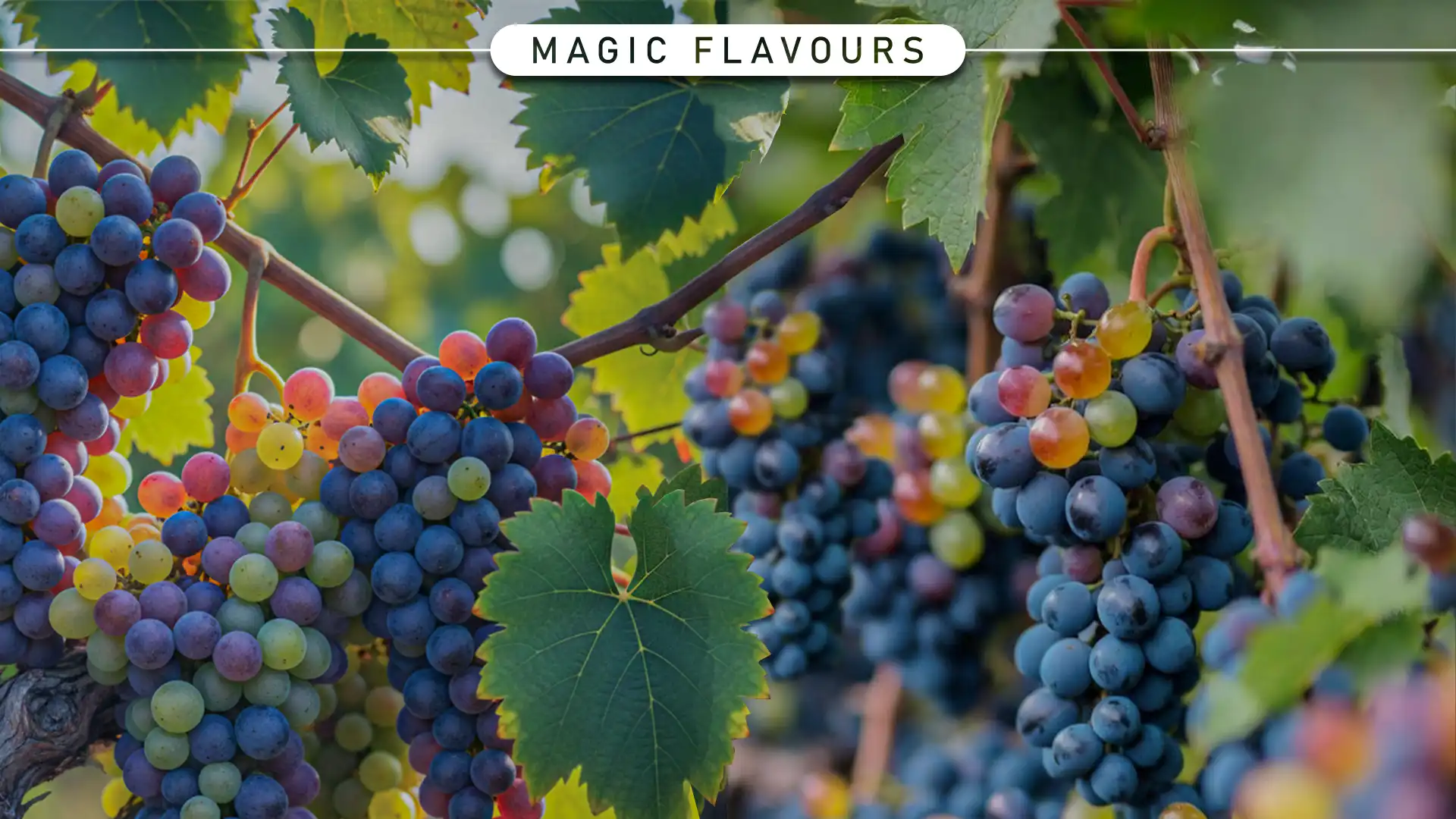1: The Sensory Power of Grape Flavor
Sweet, Juicy, and Nostalgic: What Makes Grape Flavor So Recognizable
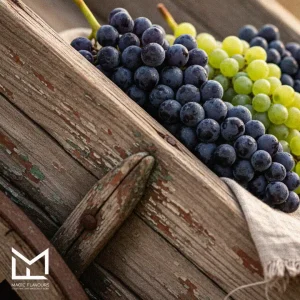
Grape flavor is instantly familiar, and it evokes childhood, comfort, and indulgence. Therefore, it performs well across age groups and formats. Moreover, its sweetness is round, not sharp, and it lingers without cloying. Because of this, grape flavor feels balanced and approachable. Even in bold applications, it remains friendly.
Nostalgia plays a role too. From juice boxes to lollipops, grape flavor carries emotional weight. So, it’s not just a taste—it’s a memory.
Aromatics and Esters: The Chemistry Behind the Familiarity
Grape flavor owes its signature to esters like methyl anthranilate. These compounds deliver fruity, floral notes with high impact. That’s why it feels instantly recognizable.
Volatiles like ethyl acetate add brightness. They lift the profile and enhance diffusion. Because of this, grape flavor performs well in open formats like beverages and molasses.
The balance of esters and acids creates depth. When tuned correctly, grape flavor feels juicy, clean, and complete. So, chemistry drives emotion.
Texture and Mouthfeel: How Grape Flavor Shapes Experience
Grape flavor interacts with texture in surprising ways. In chewy formats, it stretches and deepens. In liquids, it feels round and smooth.
Tannins add grip in adult formats. They mimic wine and elevate complexity. Because of this, grape flavor can feel playful or refined.
Mouthfeel matters. When paired with creamy bases, grape flavor softens. When layered with fizz, it sharpens. So, texture becomes part of the flavor story.
Color Psychology: Grape as a Signal of Comfort and Indulgence
Purple signals richness and calm. It’s associated with luxury, sweetness, and depth. That’s why grape flavor often carries emotional weight.
Consumers expect bold taste from deep color. When they see purple, they anticipate intensity. Grape flavor delivers on that promise.
In branding, purple also suggests creativity and warmth. So, grape flavor supports indulgent and nostalgic positioning. It feels familiar, but never boring.
2: What ‘Natural’ Really Means
Defining Natural Grape Flavor: Clean Label, Real Fruit, Real Impact
Importantly, natural grape flavor supports clean-label goals. It’s derived from real fruit, not synthetic compounds. That’s why it builds trust across categories.
Consumers expect transparency. They want to know where flavor comes from and how it’s made. When brands explain origin, they build credibility.
Natural formats also support emotional connection. They feel authentic, familiar, and safe. So, flavor becomes more than taste—it becomes a signal of integrity.
Sources: Juice Concentrates, FTNF, and Fermentation-Derived Esters
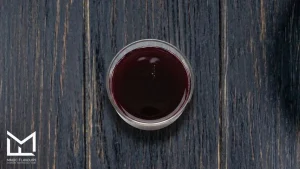
Grape flavor can be sourced from juice, peel, or fermentation. Each format offers different strengths. Concentrates deliver body, while FTNF preserves nuance.
Fermentation-derived esters mimic natural volatiles. They’re technically clean-label, but may feel less authentic. That’s why sensory testing is essential.
Choosing the right source depends on format and audience. Premium products often favor FTNF. Mass-market may lean on concentrates. So, sourcing strategy shapes perception.
Regulatory Landscape: EU vs US Definitions
Labeling rules vary by region. In the US, “natural” includes flavors from natural sources—even if modified. That offers flexibility in formulation.
The EU takes a stricter view. To claim “natural grape flavor,” it must come directly from grapes. No other fruit can contribute.
Global launches require careful planning. Regulatory strategy must align with sensory goals. That’s why early alignment between R&D and marketing matters.
Consumer Perception: Natural vs Artificial Grape Flavor
Consumers can tell the difference. Artificial grape flavor often feels louder, flatter, and less nuanced. Natural formats offer depth and realism.
Blind tests show preference for natural versions—especially in wellness and adult formats. They feel more trustworthy and emotionally resonant.
Storytelling supports perception. When brands explain sourcing and process, they build loyalty. So, flavor becomes a tool for connection.
3: Technical Formulation Insights
Formulating with Natural Grape Flavor: Challenges and Opportunities
Grape flavor is easy to love but tricky to balance. It’s bold, sweet, and volatile. That’s why formulation must be precise.
In beverages, it can dominate or flatten. In confections, it may fade too fast. Because of this, format matters. Stability tools help.
Despite its challenges, grape flavor offers strong emotional payoff. It’s familiar, comforting, and versatile. So, with the right system, it performs beautifully.
Solubility and Stability in Acidic and Sweet Systems
Grape flavor behaves differently in acidic vs sweet formats. In low pH, it may sharpen or split. In high sugar, it can dull.
Solubility depends on base type. Oil-soluble formats may cloud or separate. That’s why emulsifiers or encapsulation are often used.
Stability also depends on packaging. Oxygen and moisture degrade aroma. So, barrier films and antioxidants help preserve impact.
Heat and Light Sensitivity: Protecting the Profile
Grape flavor is sensitive to heat. Thermal processing can flatten esters and mute brightness. That’s why gentle pasteurization or cold-fill is preferred.
Light exposure also matters. UV can trigger oxidation or off-notes. So, opaque or tinted packaging helps protect integrity.
Shelf life depends on both formulation and format. When protected well, grape flavor stays juicy and clean. That’s why early testing is essential.
Pairing and Layering: Grape with Mint, Smoke, and Botanicals

Grape pairs well with cooling notes. Mint adds lift and freshness. Smoke adds depth and intrigue. Together, they feel modern and layered.
Botanicals like lavender or basil offer contrast. They soften sweetness and add sophistication. That’s why grape works in adult formats too.
Layering also helps target different audiences. Youth blends lean sweet and bright. Adult formats go dry and complex. So, grape becomes a flexible tool.
4: Application Spotlight
Grape in Beverages: From Juices to Functional Shots
Grape works across beverage formats. It’s juicy, familiar, and easy to layer. That’s why it appears in juices, sodas, and shots.
In functional drinks, it masks bitterness and adds comfort. It pairs well with vitamins, adaptogens, and electrolytes. So, it supports wellness positioning.
Carbonation lifts aroma and sharpens mouthfeel. That’s why grape performs well in sparkling formats. Whether nostalgic or modern, it delivers clarity and impact.
Grape in Confectionery: Chews, Gummies, and Lollipops
Grape adds depth to sweet formats. It stretches in chews, pops in gummies, and lingers in hard candy. That’s why it’s a staple.
Its familiarity builds trust with younger audiences. But when layered with botanicals or acids, it feels grown-up. So, grape adapts across age groups.
Texture matters. Grape behaves differently in gelatin vs pectin bases. That’s why developers test early. When matched well, it feels juicy and complete.
Grape in Wellness: Supplements and Nutraceuticals
Grape supports wellness with both taste and meaning. It’s linked to antioxidants and heart health. That’s why it appears in supplements and powders.
In tablets and effervescents, it masks off-notes and improves compliance. So, it helps consumers stick to routines. Familiarity builds comfort.
In today’s market, natural formats matter most. For example, juice-based or FTNF versions feel clean and trustworthy. As a result, they perform better in lifestyle and health-forward launches.
Grape in Hookah Molasses: A Signature Base
Grape anchors many hookah blends. It’s bold, sweet, and long-lasting. That’s why it’s often used as a base.
It pairs well with mint, vanilla, and smoke. These layers add contrast and depth. So, grape supports both classic and modern profiles.
Heat and moisture affect release. Stability tools help preserve aroma and taste. When formulated well, grape delivers a smooth, vibrant session.
5: Market Trends and Consumer Drivers
Nostalgia and Familiarity as Purchase Drivers
Grape flavor taps into memory, and it’s linked to childhood, comfort, and trust. As a result, it performs well in both mass and premium formats. In addition, consumers seek flavors they recognize, since familiarity reduces risk and builds emotional connection. So, grape becomes a safe entry point for new products.
Even in modern formats, nostalgia matters. Grape flavor feels timeless, yet adaptable. That’s why it bridges generations and supports cross-category success.
Natural Claims and Clean-Label Expectations
Clean-label demand continues to rise. Consumers want transparency, especially in flavor. That’s why natural formats outperform artificial ones.
Grape flavor derived from juice or FTNF feels authentic. It supports wellness positioning and emotional trust. So, it aligns with modern values.
Labeling matters. “Natural” claims influence perception and purchase intent. When backed by real sourcing, grape flavor becomes a credibility tool.
Gen Z and Millennial Preferences: Comfort with a Twist
Younger consumers crave comfort—but with edge. Grape delivers both. It’s familiar, but open to layering and innovation.
They also value authenticity. Natural formats feel cleaner and more trustworthy. That’s why grape performs well in wellness and lifestyle launches.
Twists matter. When paired with botanicals, smoke, or acid, grape feels fresh. So, it stays relevant while honoring tradition.
6: Strategic Positioning Tips
Storytelling Through Origin and Extraction: How to Elevate Grape Flavor
Origin adds emotional depth. Whether the grapes come from Mediterranean vineyards or local farms, each story shapes perception. That’s why sourcing matters.
Extraction method also influences trust. Cold-pressed juice feels fresh. FTNF signals authenticity. When brands explain how flavor is made, they build credibility.
Even technical details can feel engaging. Mentioning skin vs juice extraction adds nuance. So, grape flavor becomes more than a label—it becomes a sensory promise.
Sensory Language That Sells: Describing Grape Flavor with Impact
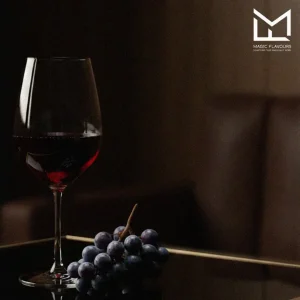
Words shape experience. Because consumers can’t taste before buying, language must do the work. That’s why sensory storytelling matters.
Avoid generic terms like “fruity.” Instead, describe the burst, the roundness, the soft finish. These details create emotional connection.
Use comparisons to guide expectation. Grape can be “like velvet with a twist” or “a juicy echo of childhood.” So, copy becomes a flavor tool.
Blending Grape Flavor with Emerging Trends: Staying Ahead of the Curve
To stay relevant, grape pairs easily with modern trends. Botanicals add sophistication. Smoke adds depth. Mint adds lift. These layers feel fresh.
Emerging formats matter too. Grape works in gels, sprays, and dissolvable. That’s why it appears in wellness and lifestyle launches.
Trend alignment builds credibility. When grape joins adaptogens or nootropics, it feels current. So, it supports innovation without losing familiarity.
7: Conclusion
Grape Flavor Is More Than a Classic—It’s a Strategic Choice
Moreover, grape isn’t just familiar—it’s flexible, comforting, and formulation-ready. That’s why it continues to perform across categories and generations.
It adapts to modern formats without losing its emotional core. Whether in wellness shots or hookah blends, it feels intentional and complete.
When used with care, grape flavor builds trust, evokes nostalgia, and supports innovation. So, it’s not just a flavor—it’s a positioning tool.
Final Takeaways for R&D and Marketing Teams
Grape offers technical ease and emotional depth. R&D teams should explore solubility, stability, and pairing strategies. Meanwhile, marketers must shape sensory language and origin stories.
Cross-functional alignment matters. When flavor scientists and brand teams collaborate early, grape performs better. That’s why shared language drives success.
Grape isn’t just a safe choice—it’s a smart one. With the right format and story, it becomes a signature.
Sampling, Collaboration, and Innovation
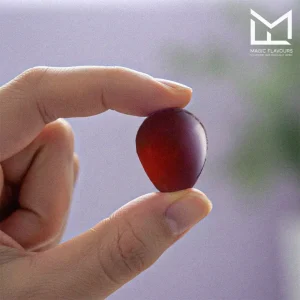
Now’s the time to rethink grape. Request samples, test blends, and explore new formats. Because hands-on experience drives insight, sampling is essential.
Collaborate across teams to unlock full potential. Whether launching a nostalgic chew or a botanical spray, grape can lead the way.
Innovation starts with curiosity. So, ask questions, challenge assumptions, and build something bold. Grape is ready—and your next product could be the proof.
